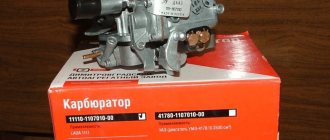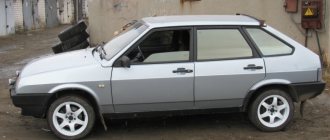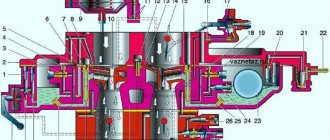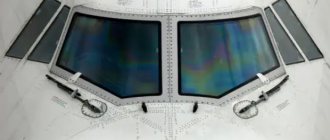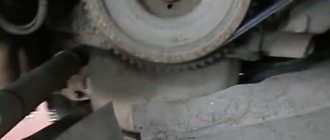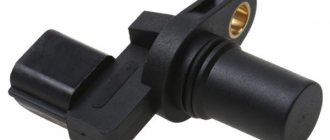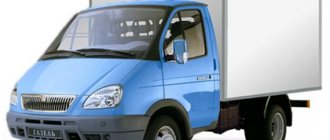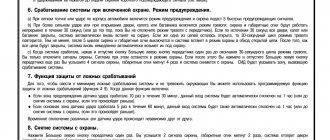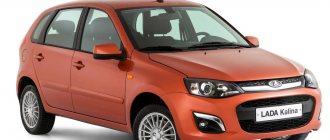The VAZ 2110 can already easily lay claim to the role of a classic VAZ car, given its age and genetic inextricable connection with previous generations of front-wheel drive cars. The tenth family did not cause such a sensation as 2108 did in its time, but is not inferior to it in popularity. Despite all the constructive archaism and unpretentious design, the top ten is respected by the public. It is easy to maintain, almost any repair can be carried out in a garage and with an average set of tools, and only the injection system, if this is the latest model, or the electronic engine control system requires special equipment. Although electronics, with the right approach, can be serviced independently. The main thing is the knowledge base. The base is not that big and not very tricky.
In the photo, the VAZ 2110 is a classic that is respected by the public
Repairing a VAZ 2110 with your own hands is easy only if you know exactly how the car works. Since the ten is not a particularly expensive vehicle, many people begin their acquaintance with automobile life with it. This is a fertile material for study, a good basis for tuning, and a practical means of transportation in space. But, of course, not without problems. The characteristic troubles that can be expected from this car have been studied far and wide, so there is no need to expect surprises from dozens, and the high degree of unification with other VAZ models makes any piece of hardware accessible, and in several versions at once.
For example, you can take advantage of the surging wave of tuning mania and the companies that have grown on its crest, which are already producing fairly high-quality modified spare parts, which could only be dreamed of five years ago. These are special timing camshafts, and drive gears of this same camshaft with a variable phase angle, and a whole bunch of power steering. Not to mention the suspension and optics, for which there are a great many options for components.
Video tutorial on how to remove and disassemble a VAZ 2110 generator with your own hands
In order not to get lost in this diversity, so that dozens of DIY repairs go smoothly and without surprises, we tried to systematize the main problems in the components and mechanisms of this car, where we will consider troubleshooting methods, options for replacing spare parts, tolerances, dimensions, shrinkage and their compliance or non-compliance with factory standards.
VAZ 2110 engine repair
More precisely, engine repair, since at different times completely different engines were installed on the car. Both carburetor ones, very close to eight and nine, and injection ones. With timely engine maintenance and compliance with regulatory maintenance standards, the engine can easily show the speedometer what 500 thousand mileage is. Not without surgical intervention, but even such figures are almost a feat for him, considering the kind of gasoline he has to pour into the tank. The Ford Focus starts to warp already at the 50th thousand mileage, and it requires a sanatorium-resort examination. The Ten can easily do without this, although it is still better to take care of the fuel system, especially the injection system.
VAZ 2110 comes with both carburetor and injection engines
Repairing the fuel system, as a rule, does not require any special expenses. Maintenance of the injector, fuel pump, timely replacement of the fuel filter and cleaning of the mass air flow sensor (MAF) are carried out in a garage without any particular problems. To carry out all maintenance and repair work on the VAZ 2110 fuel system, a special tool will rarely be required, and the only thing worth taking care of is a high-quality product for cleaning fuel system elements. They are inexpensive and can be useful when washing injectors, cleaning the air flow sensor, and on carburetor engines - when working with the carburetor, as well as when washing the lock and other hard-to-reach places. It should be borne in mind that the use of solvents and aggressive chemicals is extremely undesirable. If you handle them carelessly, you can destroy some rubber seals and cuffs, which are sufficient in both carburetor and injection systems.
Repair of the ignition module, ECU, and on-board computer can, in principle, be entrusted to services if necessary. Nowadays, it is not at all uncommon to find improved injection system control modules and ignition modules with prompt changes to their settings. Therefore, there is no need to carry out chip tuning of the 2110 on a full scale. Thus, the January injection system controller of the latest releases can provide the greatest opportunities for making changes to the operation of the fuel system and ignition system.
This is a very convenient thing. The January controls are located in the cabin, and in order to make changes to the settings mode, you just need to press the corresponding button, and the system will reprogram the injection and ignition algorithm, which will allow you to change the dynamic and operational characteristics of the engine in real time without any surgery or digging in the brains of the car. A module has been developed specifically for the tenth family, which allows you to simply switch the injection system to economy mode or sports mode on the go. And at any time you can reset the settings to standard factory settings.
Repair of the VAZ 2110 fuel system can be carried out within your garage
Repairing electrical equipment and power electrical devices - starter, generator and the relays that serve them, also does not present any difficulties. The main thing here is to know the location of the relays and fuses. In 2110 they are already more or less systematized and collected almost in one place, so there is no need to spend a long time searching for this or that relay. There are, of course, some oddities in their systematization, especially since the plant made changes throughout the entire production of the car. But there is still a certain logic in their placement.
Are the valves bent?
Each engine in a Lada Priora car bends a valve, this also applies to the most powerful unit number 126 by 16. They will tell you this in any service center that services domestic cars. But novice drivers should know that the engine bends components for a reason, and if you follow the operating rules, you will not encounter this problem.
The Lada power plant bends parts only if the routine work to replace the belt and other components of the gas distribution mechanism (GRM) is violated. The motor bends the valve if the rollers, belt or water pump were not replaced in time. When one of these elements breaks, the number 126 pistons meet the valves. Due to this design feature, the motor bends the parts. The solution to the problem is a major overhaul of the Lada.
So, the task of the owner of a Lada Priora with engine number 126 for 16 cl is to check the timing belt in a timely manner.
The rollers and timing pump number 126 should also be given attention when inspecting the belt. After all, the engine bends parts even with faulty rollers
Sometimes the timing belt and its components wear out prematurely - you will know this by vibrations from the engine compartment and an unpleasant grinding noise. Engine number 126 bends the valve, so do not forget to change the timing components in time and repair this unit.
VAZ 2110 suspension repair
The simple, understandable and reliable suspension 2110 does not require any special or costly measures for maintenance and repair. Chassis repair involves, first of all, eliminating the consequences of driving on our less than ideal road surfaces. In this regard, the top ten also compares favorably with more recent and much more expensive foreign cars in the budget segment. If you have a lift or, in extreme cases, an inspection hole, any part of the front suspension can be easily replaced or repaired with your own hands using basic tools. There are some peculiarities in the repair of front struts, support bearings and stabilizer bars, but they are present in every car.
Steering rack repair requires special attention. Its dismantling is simple, but the reassembly process itself can cause some difficulties, since there is a need for some pullers and calibrated samples. But it is enough to disassemble it yourself once, and in the future its maintenance will not cause problems. When repairing a steering rack, it is imperative to use the correct repair kits. And full. They can be sold either as a simple set of seals and a bushing, or as a complete repair kit with a bearing, corrugations, the same bushings and seals, as well as retaining rings. Considering that you will have to spend a good half day replacing a repair kit, it is better to replace the complete set.
Installation of pistons and connecting rods
The next step is to install the pistons on the connecting rods. Pistons and connecting rods have a certain direction in relation to the engine. The arrow on the pistons indicates the forward direction, that is, they should be directed from the flywheel towards the front cover.
There are numbers on the connecting rods; they should face forward in the same way.
Taking this direction into account, we connect the piston and connecting rod using a piston pin. Before installing the pin, the piston must be heated; just place it in hot water for a few minutes. In the piston, the pin is locked on both sides by retaining rings.
Body and transmission repair
The VAZ 2110 gearbox very rarely causes any complaints. Most often, the cause of difficult gear shifting is wear or breakage of the linkage. This is not the worst problem, and it can be solved quite simply. Moreover, you need to make it a rule to inspect the condition of the gearbox and rocker bearings during every repair or maintenance of the clutch. It often requires attention, especially if a disc with low-quality friction linings is installed. They wear out many times faster than branded ones, and rivets can damage the working surface of the flywheel and clutch basket.
In a VAZ 2110 you need to check the condition of the gearbox very often
Body work can be carried out with a minimum of experience, which is gained as the same body work is carried out. So this vicious circle must be broken and learn to independently replace thresholds, treat the bottom and cavities with anti-corrosion compounds, wheel arches and internal door cavities. There are now all the conditions and necessary anti-corrosion mastics and compounds for this. Epic Movil and construction bitumen mastic are a thing of the past, so there will be no problems with choosing such products. And if you do a complete anti-corrosion treatment of the body at least once every two years, then you can forget about rust for a long time.
This is interesting: Video of repairing a VAZ 2107 generator with your own hands
Repairing the bumper and other plastic body elements, covers, panels, and heater casings can be done independently, using several methods. This does not require any special skills or material costs, and saving a damaged bumper or plastic body kit with your own hands is much cheaper than buying a new one. These issues can be solved with the help of a powerful soldering iron, plastic electrodes and a hair dryer. The entire work, depending on the size of the injury received, may take no more than two hours. And the money saved on repairs can be spent on purchasing good putty and a set of spatulas, which will undoubtedly be useful for minor repairs to the body or the same bumpers.
There are archaic and some imperfect solutions in the design of car brakes, but taking into account their simplicity and the availability of components, everything can be solved in the conditions of an average garage. Front disc brakes are repaired in extreme cases and when the brake disc is critically worn, and the brake pads can be selected to suit your preferences and driving style. If the driver prefers a softer and more leisurely driving style, then it is worth choosing soft pads.
They are less noisy, operate softer, and do not wear out the brake disc as much. If your driving style is aggressive, then with soft pads you will have to change them quite often, and the braking force at high speeds may be insufficient. In this case, you should pay attention to the so-called sports brake pads. They are noisier, harsher and grip very sharply; with active use they wear out the brake disc. The rear brakes are a separate matter, since their design goes back to the days of the Fiat 124.
The design of the VAZ 2110 brakes has some imperfections
The factory never bothered to replace them with disk ones. Under normal operating conditions, they do not cause leaks, they just need much more attention than they deserve. As a last resort, there is always the option of replacing it with a disc brake with some modifications. Nothing is impossible.
The reliable, well-made, but somewhat outdated VAZ 2110 has not yet finished its song, and it may well be useful and teach a novice car enthusiast to hold a screwdriver in his hands and distinguish a switch from a radiator. And for an experienced driver, this is an indispensable car for every day and a reliable assistant.
Cost of major repairs
One of the main questions that worries car owners is how much it will cost to perform a major engine overhaul. Here are approximate figures as of winter 2017/2018. For a VAZ car model from 2101 to 2112, depending on the amount of work performed, the amount will be approximately equal to 27 to 38 thousand rubles.
It will cost separately to diagnose the engine and ECU for errors with an electronic scanner, and if they are detected, appropriate corrections or simply reset. It also costs some money to measure engine compression. As for foreign cars, it all depends on the make and model of the car. However, the indicated price will need to be multiplied by at least one and a half times.
Reasons for repairing a VAZ 2110 with your own hands
- Relatively low prices for spare parts.
- Aerodynamics of high quality.
- Galvanized metal body.
- Soft suspension.
Do-it-yourself maintenance and repair of the VAZ 2110 is accessible and inexpensive. Buyers' interest is also caused by relatively low fuel consumption. The car is represented by a five-seater cabin with a front engine in the car, the drive is located on the front wheels. The body has a supporting structure of an all-metal welded type.
Installing pistons into liners
Once the rings are installed, the pistons can be inserted into the cylinder liners. To do this, tighten the piston rings with a clamp. We install the liner into the lower head of the connecting rod. In such a way that the lock on the liner fits into the recess of the connecting rod head bed. We insert the connecting rods with the piston into the sleeve until the clamp stops. Taking into account the direction of the piston, and with light blows, preferably using a wooden block, we force the piston into the sleeve. By guiding the lower end of the connecting rod into the crankpin of the crankshaft. After the connecting rod rests against the crankshaft with its liner. We install the connecting rod bearing into the connecting rod cover, and put the cover on the studs. In this case, it is imperative to take into account that the liners on the connecting rod and the cover are located in relation to each other, lock to lock.
We tighten the cover with nuts in two stages. The final tightening must be done using a torque wrench with a force of 42.32-53.51 N*m. Install the remaining pistons in the same way. Always be mindful of their direction in relation to the engine.
Types of repair work
Important repair stages are scheduled and seasonal repairs. Mandatory vehicle maintenance includes diagnostics, repairs and adjustments. There is a simple, non-labor-intensive job that you can easily do yourself. For difficult work you will need additional equipment and good tools. If the machine is operated in particularly harsh conditions, experts recommend reducing the mileage for routine maintenance to 5 thousand km. Routine car repairs include:
- replacing used oil;
- replacing filters (oil, fuel, air);
- engine diagnostics with inspection of the brake system;
- replacement of steering mechanisms with chassis.
If necessary, after inspecting the VAZ 2110 car, the following is carried out:
- injector cleaning work;
- economizer adjustment;
- replacing brake pads;
- adjustment of wheel camber angles;
- replacement of brake cylinders with hoses;
- replacement of shock absorbers.
Repair and operation of VAZ must be carried out in strict accordance with the rules. A seasonal inspection is done every six months. The repairman is not limited to replacing tires on a car during the season. VAZ repairs can be carried out both in showrooms by qualified specialists and on our own. Based on work experience, year of manufacture and condition of the car, the master can easily tell the approximate mileage before subsequent repairs.
How does a malfunction of the electronic control unit affect the operation of the injector?
The electronic control unit of the VAZ-2110 car consists of 3 high-precision components:
- ROM – devices for storing data (memory);
- PROM – a device for transmitting dynamic data;
- RAM is the regulating memory of the block.
Advice: the entire complex of presented elements will function only if there is voltage in the circuit. If there is no voltage in the wiring, then it is necessary to eliminate the faults in the fuse box on the VAZ-2110.
Thus, the electronic control unit acts as a kind of microprocessor that is responsible for the operation of the entire fuel supply system. If it breaks down, even an experienced motorist cannot fix it with his own hands. For repairs, contact your nearest car service center and wait for the result. If the unit does not have any malfunctions, the breakdown must be looked for among the elements of the injector and controller.
Tip: in the center of the dashboard on a VAZ-2110 car, a warning light called “CHECK ENGINE” may light up. In this case, the problem definitely does not lie in the control unit, the problem is related to malfunctions in the controller.
So, if you notice that your engine begins to constantly stall while driving and spends more fuel at the same distance as before, refer to the injector diagram for the VAZ-2110. Having a little understanding of each of the elements, you can quickly find the faulty element and replace it.
Car repair tips
To carry out ordinary simple repairs of a VAZ 2110 on your own, you need to have a minimum of tools. Repair includes the following operations.
- Adding used fluid (brake, coolant, for washing external windows) or new oil to the engine.
- Adjusting the headlights.
- Replacing filters.
- Replacing brake pads
- Recharging batteries, replacing sensors, checking tire pressure.
To carry out routine repairs, you will need an inspection ditch (pit) and a special lift. To carry out complex repairs, where it is necessary to replace parts of all suspensions, you will have to invite competent and physically trained assistants. You need to use a professional tool. The most labor-intensive and expensive are the major repairs of the body and engine.
Experts do not recommend performing this work in artisanal conditions. This is especially true for those who do not have practical skills, the necessary special equipment and the necessary tools. It may be impossible to eliminate the consequences of incorrectly and unprofessionally performed major repair work on an engine; it is often necessary to replace it completely.
Signs and causes
It is worth mentioning that the signs listed below may not directly indicate the need for major repairs, but only indicate a malfunction of individual components and mechanisms of the vehicle. But if several of the described facts appeared at the same time, and the mileage since the last repair is significant, then, most likely, they will indicate the need for a major overhaul. So, these include:
- knocking in the crank mechanism;
- decrease in engine oil level and/or pressure;
- increased oil consumption;
- dark blue or purple gas comes out of the car's exhaust pipe;
- The compression has dropped significantly (to measure it, you need to use special equipment at home or at a service station).
Now let’s look at what may cause the need for major repairs, that is, the reasons for this:
- contamination and/or aging of the oil in the engine crankcase, coking of the latter (in some cases it is possible to use low-quality oil, simply put, counterfeits);
- complete or partial failure of plain bearings in the crank mechanism or crankshaft liners;
- compression can drop for several reasons - wear of the piston rings, burnout of valves or cylinder head gaskets;
- Engine oil consumption can also be caused by various reasons - failure of valve stem seals, clogging of oil scraper rings with burnt oil, and so on.
Usually the reasons described above do not appear immediately. They are the result of natural wear and tear of individual engine parts, as well as the fact that the car owner did not carry out routine maintenance on time to restore the components and systems of the car. Therefore, in order to delay major repairs, you must follow a few simple rules:
- monitor the level and condition of the oil in the engine crankcase;
- avoid significant overheating of the engine (do not drive at high speeds and ensure that the cooling system is working properly);
- fill with high-quality fuel;
- do not overload the engine for a long time;
- do not allow the engine to idle for long periods of time;
- try to avoid dynamic driving with sudden acceleration and braking.
These seemingly elementary rules, unfortunately, are neglected by many car enthusiasts. And this leads to very sad consequences for the car, and significant financial costs for their owners.
Purpose
The wheels are attached to the front suspension; the unit provides shock absorption for the “front” of the car, is responsible for stability while driving, wheel adjustment, camber, and toe-in.
The front suspension design of the VAZ 2110 is quite complex, but any of you can figure it out. The main thing here is to arm yourself with an instruction manual, as well as understand the essence of the main angles.
Main front suspension components
The main element of the front suspension is considered to be a hydraulic telescopic strut , which is simply irreplaceable in the matter of shock absorption and ensuring a comfortable ride on the car. The car won’t shake much, and going through every hole won’t turn your trip into a nightmare.
To change the wheel camber, there is a strut in the front suspension. To be more precise, the steering knuckle and the upper bolt, which has an eccentric washer and a belt, are responsible for this process.
Mounted on the rack:
- Special springs;
- Buffer to limit the compression stroke. On the VAZ 2110 this element is made of polyurethane;
- Upper support. It is attached to the rack, to which, in turn, the mudguard is attached. Please note that only self-locking nuts are used for fixing. Therefore, ordinary nuts will not work for repairs;
- Bearing to ensure rotation of the stand together with the wheels;
- Shock absorbers with spring and plunger.
By the way, the cross member of the front suspension of the VAZ 2110 is a bar to which the lower arms are connected. In the center it is attached to the body using a rubber cushion.
This is a brief diagram of the front suspension of the VAZ 2110, your instruction manual will help you get to know it better. Many motorists underestimate the importance of this literature, which the manufacturer attaches to each of its cars. But in fact, the necessary, useful and important information about each component, unit and system of the machine is presented in detail and in all colors. Including the front suspension, of course.
Cleaning valve channels
To remove any valve, you will need to remove the camshaft. All screws on the bearing housing must be unscrewed evenly and tightened with a force of 10 N*m. The hydraulic compensator can be removed with a magnet, and then the valve is desiccated by compressing the spring with a puller (see photo).
How to remove the valve
There may be carbon deposits in the valve channels. It is cleared:
- Flat screwdriver;
- Sanding felt.
Grinding is carried out as follows: a rubber pipe is placed on the valve, a paste with diamond chips is applied (one drop), then the valve is pressed into the channel and scrolled. It will also be possible to change the valve stem seals (2112-1007026). You can’t do this without a special puller.
Cap puller
On any car, including the VAZ-2112, cylinder head repair comes down to cleaning and checking, as well as correcting geometry defects. In the latter case we are talking about milling. The presence of cracks and chips is a reason for replacement, not repair.
A small photo report
A burnt valve is immediately visible.
One valve burned out in cylinder 2
Carbon deposits were found in each valve channel.
Carbon layer in the cylinder head channels
Repair: cleaning all channels, replacing the valve with lapping. Direct repair of the VAZ 2112 cylinder head will require several operations that require some special equipment. Of course, this is not possible at home, and car enthusiasts simply replace worn parts. Next, we will consider the process of repairing the block head, as well as some of the nuances associated with this work.
Typical faults
The front suspension is characterized by certain breakdowns, which are determined by two phenomena:
They should be considered separately, since the reasons for their appearance are different.
Knocks
If you start to hear knocking noises coming from the front suspension, this could be caused by several reasons:
- The rack has certain faults;
- The ties on the cross member, the cushions are worn out or the bolts are loose;
- The attachment to the body was not strong enough;
- The springs have failed;
- The hinges are worn out;
- The rubber part of the suspension has broken its integrity. The knock should be clear, like the impact of metal on metal;
- Wheel alignment is out of balance.
If you do not hear a knock, but a noise, then the causes of front suspension problems may be as follows:
- The bolts that secure the stabilizer bar to the body have become loose;
- The rubber components in the strut support have collapsed;
- The rubber pads of the coupler or rod are worn out;
- The suspension spring has broken or violated its geometry;
- The wheels are unbalanced;
- The compression stroke buffer has collapsed.
Increased tire wear
If you are not a fan of fast acceleration, harsh braking, or do not overload the car, then the reasons for increased wear may be:
- The wheel alignment angles are incorrect;
- The hinges are worn out;
- Wheel balance is off.
Repair stages
To do this, you need to have screwdrivers and wrenches, an assembly blade, torque wrenches, a soft hammer, and a device for installing the pistons.
The algorithm of actions is as follows:
- First you need to disassemble the motor. This will not be difficult, but all actions must be performed slowly and carefully.
- First of all, you should remove all accumulated carbon deposits that are located in the area where the cylinders are located. It is imperative to remove carbon deposits located in the oil grooves in the area of the cylinder beds.
- After this, you need to insert the bearing shells. In this case, you should focus on the marks that were made during the disassembly of the motor. The locking-type antennae of the liners must fit exactly into the grooves that are in the beds. You definitely need to keep an eye on this.
- Now you should coat the liners with oil.
- Next, you need to install the crankshaft in the cylinder block. Then the half rings are lubricated with oil. When installing, you need to check that the grooves on them are directed precisely towards the crankshaft cheeks.
- Then you need to install half rings, which are made of a compound of aluminum and steel. They are distinguished by a white tint. Installation is carried out on the front side in a bed located centrally.
- On the other hand, a metal-ceramic ring needs to be secured to the bed. It has a yellowish tint.
- Next, the half rings, which are already installed, need to be rotated so that the ends of the parts are located at the end of the cylinder bed.
- Now you need to mount the bearings (root) of the liners into the covers. Again you need to look at the marks that were made when the unit was disassembled. You need to make sure that the locking type antennae fit exactly into the grooves. Then the liners need to be well lubricated.
- After this, the covers are installed. Be sure to look at the numbering of them and the cylinder.
- Then you need to coat the threads on the bolts and the ends where the covers will be secured with engine oil.
- Then the third cover is used, and the bolts are tightened again. The same should be done with the bolts on the 3, 4 and 5 covers. Moreover, everything must be carried out in exactly this sequence.
- When all the bolts are tightened, you need to check how easily the crankshaft moves. To do this, turn it several times.
- Then the oil pump is installed and fixed. After this, you need to do the same with the holder for the oil seal located at the rear.
- A connecting rod is installed in the piston. And then the piston pin is inserted. Be sure to oil both the connecting rod itself and the pin.
- Install retaining rings. Check that they are in the grooves.
- Then the oil scraper ring and the piston ring are installed. It is best to have special equipment for such manipulations. The tool is called a puller.
- You need to check that the ring can rotate freely.
- Wipe the connecting rod journals located on the crankshaft. The same applies to the cylinder mirrors.
- A liner is installed in the connecting rod, and the antennae must be exactly located in the connecting rod. The piston and liner need to be lubricated, and then a compression ring must be installed. The connecting rod is lowered into the cylinder.
- The mandrel must be attached to one side. Next, use a regular hammer handle to push the piston.
- The connecting rod head should be mounted to the crankshaft journal area.
- Insert the cover and secure it. Make sure that the markings on the bottom and on the roof are clearly on the same side.
- All the bolts are tightened, and then all the other pistons are installed.
- Secure the oil receiver.
- Install the flywheel and plate. Be sure to first use an anaerobic type clamp to secure the bolts.
- A layer of lubricant is applied.
- An oil sump is installed.
Why does the car pull to the side?
Sometimes drivers notice how, when driving in a straight line, the car begins to pull to the side. There are several reasons for this phenomenon:
- Each spring has its own specific compression ratio. If it loses elasticity, the element must be replaced;
- Tires may have different pressures. Check this first;
- A rubber component on one of the strut supports has collapsed. In such a situation, a characteristic knock may appear. The situation can be corrected by simply replacing the element;
- The wheels are set at the wrong angle. A common cause of tire wear. It is better to trust such a problem to a specialist, since it is difficult to repair the front suspension on a VAZ 2110 with your own hands in case of such a malfunction.
This is interesting: Replacing a 402 engine with a 410
How does the controller monitor the operation of the injector?
When determining the specific position and opening time of the injector design, the specific volume of fuel entering the valves of the VAZ-2110 cylinder is determined. At the same time, thanks to special sensors installed on the motor, the on-board computer records specific values and transmits them to the controller.
Subsequently, the controller, based on the information coming from the on-board computer, makes a decision on the position and duration of opening of the injector damper. If the controller malfunctions, the injectors will not be adjusted correctly, and the engine may stall while driving.
Tip: when starting the engine, the injector controller operates in asynchronous mode until the engine reaches a certain number of revolutions. That is why, after replacing the silent blocks of the front control arms on a VAZ-2110, you should warm up the car for 10-15 minutes.
Examination
- Experts recommend paying special attention to the protective covers of the joints, monitoring their condition, and also checking the front suspension for mechanical damage.
- Make sure that neither the front suspension arm of the VAZ 2110 nor any other element has cracks or other visible damage. Pay attention to checking the connection points of the elements.
- If the components are deformed, the angle of the wheels will most likely be disrupted and they will no longer be able to be adjusted.
- Check ball joints, hinges, upper stack mounts, cushions. If there are breaks in the rubber elements, they must be replaced.
- Measure the distance between the lower arm and the brake disc. This way you can check the condition of the suspension joint. If the distance is more than 0.8 millimeters, the hinge must be replaced with a new one.
- If the buffer shows signs of destruction, it should be replaced immediately.
- The spring is replaced if it has failed or sagged.
- Ball joints are replaced when they are worn or deformed. Other hinges must be replaced if they or the stabilizer bar struts are worn out.
- All rubber elements change under conditions of deformation or failure.
- If the fastening of the upper strut mount to the body is loose, simply try to tighten the fastening. Most likely, no major intervention will be required.
Understanding the structure of the front suspension, as well as audibly or visually identifying its malfunctions is quite simple, despite the apparent complexity of the assembly. But you should approach the issue carefully and periodically check the condition of the suspension, even if its malfunction is not indicated by any noise, knocking or behavior of the car on the road.
For any car, it is better to organize preventive maintenance than to later pay exorbitant prices for a full repair. Like a disease, it is better to prevent problems with the front suspension of the VAZ 2110 from occurring. It is cheaper, simpler and more correct on the part of the car owner.
Main signs for dismantling the cylinder head
The manufacturer did not provide any regulations for replacing auxiliary parts of the cylinder head, but there are some signs that will still require dismantling it.
- Presence of mechanical traces on the cylinder head.
- The presence of engine oil or antifreeze leaks at the junction of the cylinder head with the block.
- If white steam comes from the exhaust pipe, this will mean that antifreeze has got into the cylinders and you cannot do without removing the cylinder head.
- Emulsion foam on the expansion tank cap indicates that exhaust gases have entered the cooling system.
- There are traces of oil in the coolant reservoir - this indicates a leak in the system.
- A white coating is observed on the engine oil dipstick, which tells us that there are traces of antifreeze (antifreeze) in the oil. The work will require removal of the cylinder head.
Tags: repair, maintenance, VAZ tuning, faq
Comments 52
Good afternoon everyone! I ran into trouble that circumstances forced me to install an unloading relay on the starter, but I have a question about the correctness of the circuit that I used in this community: www.drive2.ru/c/48003/ why is it better or worse than this www.drive2.ru /c/595839/ There is no selenium in the electrics, I’m afraid of burning the car
Have a good time everyone. Need help, the dashboard lights are constantly on, when you turn on the ignition, not a single light comes on. Maybe someone had this.
hi all! Tell me what to do, I changed the sensor, drove 500m, and everything is new (the check light is on) ps there are no deviations in the car, everything is normal. NOT troit,
maybe the hall sensor is working, if only the switch or coil?
VAZ 2110 carburetor at first troubled then everything, tried with A3-1, thought hall sensor, silence
here not long ago there was a 2112 that had a muzzle and rear arches made under the coupe, I can’t find it, help
I just have the first ten, I don’t really know anything about it, I just found the manual from you)
Yes, I have. If viburnum or Priora, or. you'll find it too
thank you, a lot of useful and necessary information) I wish there were more such wonderful people)))
that's exactly why) good luck
Add a topic! Replacing the foam lamp socket with a cigarette lighter. In my blog, here is the link www.drive2.ru/cars/lada/2…3/glebing/journal/202385/
There are no priors in the family yet. I’ll definitely take the advice. Thanks
Thanks for the info. I downloaded it on both Kalina and 10.
I saw an electronic version of Murzilka somewhere, but I can’t find it anymore, can anyone tell me? Not PDF, but in program form.
Whoa! Like this! In fact, I forgot that I needed it.))) I’ll go look for it on the tracker. Py-Sy. Here, I hope it will be useful to many! yadi.sk/d/JBFUaKkqdD5GW
What about removing and installing the internal combustion engine? Also a useful topic: How to do what, you can look in my blog
how to pull the power wire through the elastic band of the hydraulic corrector?
And also, I have a proposal to create a topic on consumables, what kind of oil, brake pads and timing belt, etc. I can even fill it out myself
Thank you, the manual has been added to the community FAQ. Everything is well written and the photos are on point! We need a topic regarding consumables; the same type of questions are asked every day. Will you do it?
I’ll do it, but the topic will need to be fixed in the same way as the faq.
And also, I have a proposal to create a topic on consumables, what kind of oil, brake pads and timing belt, etc. I can even fill it out myself
+1. suspension, pads, calipers, tips and all that from me
I would like to know something about the power steering and rack, otherwise the Murzilkas don’t have anything on the power steering, mine is leaking, I plan to sort it out when it gets warmer. I would like to know what to prepare for and where the difficulties are.
on the treatment of outgoing corners on the dashboard near the air intakes
How to distinguish original MAFs from fakes, a very useful link
Maybe someone will be interested in what an absorber is. The feedback injection system uses a fuel vapor recovery system. It consists of an adsorber installed in the engine compartment, a separator, valves and connecting hoses. Fuel vapor from the tank partially condenses in the separator, and the condensate is drained back into the tank. The remaining vapor passes through gravity and two-way valves. The gravity valve prevents fuel from leaking out of the tank when the vehicle rolls over, and the two-way valve prevents excessive increase or decrease in pressure in the fuel tank.
Then the fuel vapor enters the adsorber, where it is absorbed by activated carbon. The second fitting of the adsorber is connected by a hose to the throttle assembly, and the third to the atmosphere. However, when the engine is turned off, the third fitting is closed by an electromagnetic valve, so that in this case the adsorber does not communicate with the atmosphere. When the engine starts, the injection system controller begins to send control pulses to the valve with a frequency of 16 Hz. The valve communicates the adsorber cavity with the atmosphere and the sorbent is purged: gasoline vapors are sucked through the hose into the receiver. The greater the engine's air consumption, the longer the duration of the control pulses and the more intense the purging.
In an injection system without feedback, the system
Dismantling the cylinder head
First of all, to get to the cylinder head, you need to remove the cylinder head cover. For different 16-valve engines, this operation is different, and the cover part numbers also look different: 2112-1003260 (-10) and 21124-1003260.
Engine cover VAZ-21124 (1.6 l)
You will also need to remove the timing belt - there are no differences between different engines.
Let's look at how the exhaust manifold can be detached from the cylinder head. On engine 21120:
- Remove the exhaust pipe of the muffler: unscrew two nuts 1 (key “13”), remove the clamping bar, unscrew six nuts 2 (key “14”) and dismantle, not forgetting to turn off the oxygen sensor. The photo shows three of the six nuts.
Elements of the exhaust pipe
Everything important is under the screen
Now we will talk about engine 21124:
- Disable both oxygen sensors. We unscrew the three nuts securing the protective screen (with a 10mm wrench) and disassemble the bracket by unscrewing the four nuts with a 13mm wrench.
How to disassemble the mounting bracket
Operation with additional muffler
Here we believed that the VUT hose was disconnected from the intake module. Finally, the spark plugs are unscrewed on any of the engines (a “16” tubular wrench).
The order of unscrewing (left) and tightening the mounting screws
DIY VAZ 2110 repair
In the photo there is a red Lada Ten - a four-door front-wheel drive domestic sedan.
VAZ-2110 is a small class car made in Russia. Production began at the VAZ plant in 1995. In 2007, the last car, model 2110, rolled off the assembly line.
The model was produced under the VAZ 2110 and Lada 110 brands. The “folk” names of the model are Zhiguli, Desyatka.
Initially, the VAZ 2110 was produced only as a sedan with four doors. The car was equipped with front-wheel drive and an electronic engine control system. For the first time, an on-board computer was installed on a Russian car model.
Design and principle of operation of the ignition module
Some old-school motorists call the modules double-spark coils, which makes sense. After all, the coil is the predecessor of the ignition module in the technical evolutionary chain. The module is a paired design consisting of two pairs of windings (primary and secondary) and a switch that alternately switches low-voltage current from one coil to another. In some models of double-spark coils, the commutator is structurally located outside the block.
The operation of the module is controlled from an electronic unit that collects and analyzes information from various working components of the engine. The block, unlike the classic coil, has 4 sockets for connecting high voltage wires going to the spark plugs. The pulse occurs in pairs, first at terminals 1 and 4, then 2 and 3. That is, each of the built-in coils is responsible for the operation of two cylinders. A spark occurs simultaneously, as a pair.
This is what one of the ignition module models looks like. The connector for connecting incoming wires is visible at the top.
At the input, the ignition module has a connector with four terminals. Usually most models have markings opposite them. Pulses from the Hall sensor alternately arrive at contacts A and B, serving as a signal to switch the commutator from one primary winding to another. C and D – ground and power supply (12 V), respectively.
Engines
On the domestic market, the model could be purchased with one of three engine options:
- 1.5-liter 8-valve engine, 69 hp. Model 2110 base carburetor powertrain;
- 1.5-liter 8-valve engine, 79 hp. Accelerates to hundreds in 14 seconds;
- 1.5-liter 16-valve engine, 94 hp. The most powerful version of the power unit. Acceleration to 100 km/h takes 12.5 seconds.
8-valve engines have valve protection - they do not bend if the timing belt breaks. There is no such protection on a 16-valve power unit.
All VAZ engines require timely maintenance. Failure to meet replacement deadlines may result in major repairs.
During operation, the intake manifold fails. Repairing a problem yourself requires a lot of time and effort. Repairs at a service station will cost twice as much. If you have no experience in such work on your own, it is better to turn to specialists.
Tuning
Simple firmware or chip tuning for 124 engines will not change the technical characteristics. To significantly increase power, it is necessary to modify the engine.
- The simplest and most common tuning of the 21124 engine is the installation of sports camshafts, a direct-flow resonator, an increased throttle - in this way you can increase the power to 120 hp. Installing a lighter piston engine can add some power to this. This, at the same time, will reduce the fuel consumption of the VAZ 21124.
- About 150 hp can be ensured by modification of the cylinder head and installation of camshafts with increased valve opening phases.
- Installing a compressor has approximately the same effect; it is installed on eight-valve and sixteen-valve engines.
- Stable engine operation at any speed is ensured by installing four chokes, one for each cylinder. According to popular experience, the most suitable option is to install an injection system from ToyotaLevin. To do this, a set is assembled from the chokes themselves, an adapter manifold, a zero-resistance filter, injectors, an absolute pressure sensor and a fuel pressure regulator. Due to the fact that the speed exceeds the limit, it is necessary to install lightweight piston and wide-phase camshafts. With this modification, engine power can reach 200 hp. But such modernization sharply reduces the service life of the engine, is fraught with frequent breakdowns and the need to carry out serious repairs of the VAZ 124, due to the fact that the engine easily and often spins up to 9,000 rpm.
